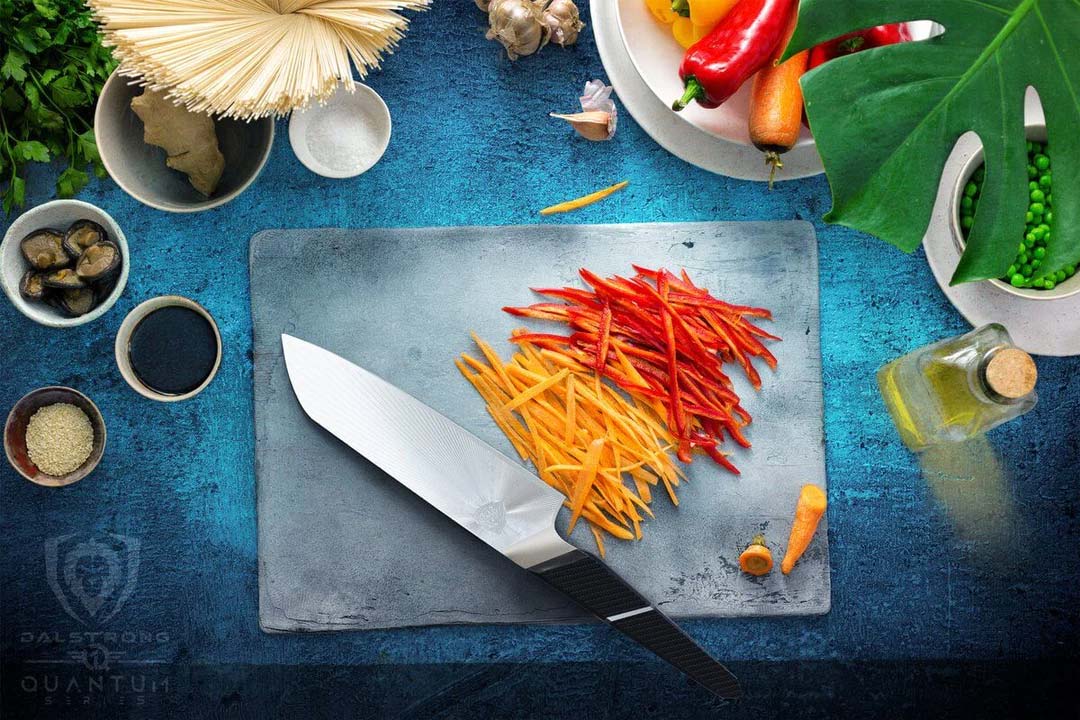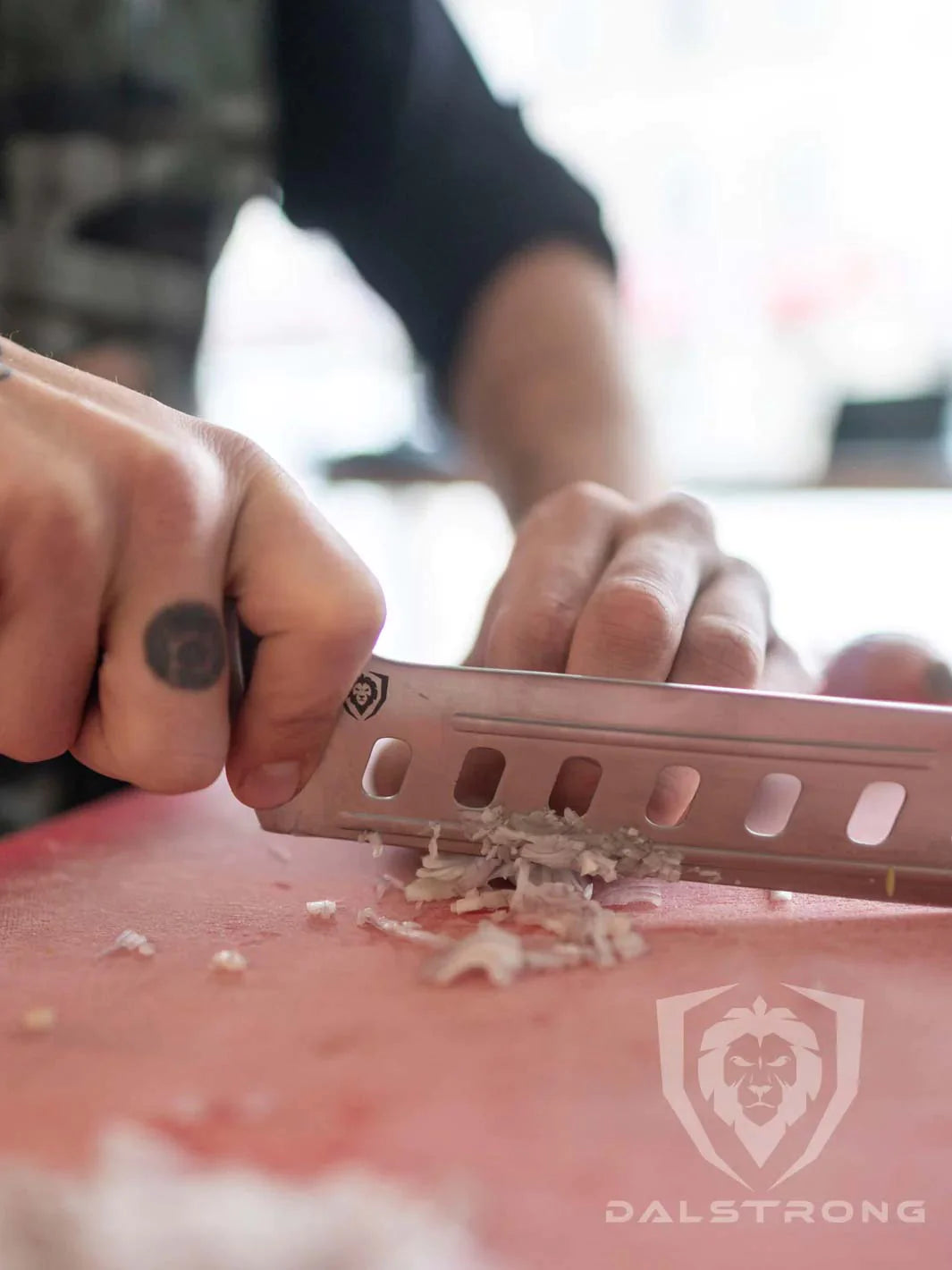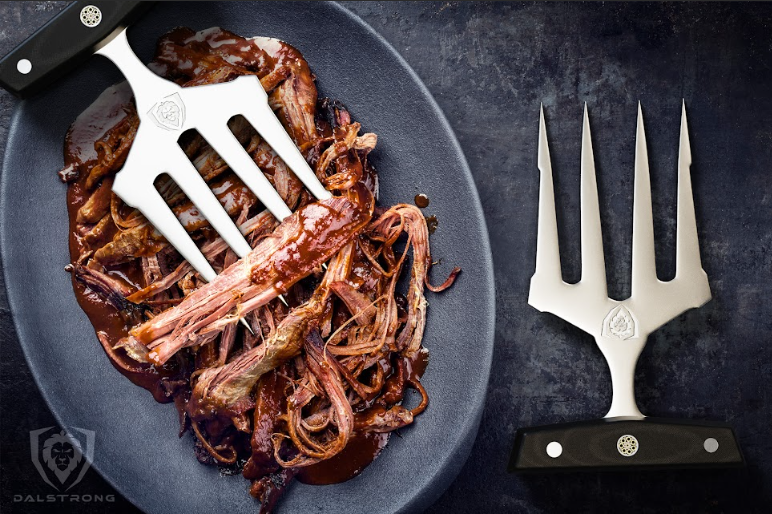How To Cut A Pear In Different Ways

Quick Overview: How To Cut A Pear
- Gather tools: knife, cutting board, optional melon baller or spoon.
- Wash pears under cold water to remove dirt.
- Cut pears in half lengthwise; optionally remove seeds and core.
- Use a melon baller for decorative pear spheres.
- Slice horizontally for snacks or artistic presentations.
- Cube for texture in salads or desserts.
- Peel, halve, and core for various culinary uses.
- Make thin slices for delicate charcuterie board additions.
- Store cut pears in the fridge, drizzle with lemon juice to prevent browning.
- Get creative with different cuts and enjoy the pears!
Growing up in Asia, I’ve eaten a good amount of pears. They’re sweeter than apples with a softer yet raw texture. And, even today, they make the sweetest dessert pairings after a wholesome meal. Here’s everything you need to know about pairs, their nutritional value, how to cut them in different ways, and the best Dalstrong tools you will need to do this with ease. So, let’s dive right into it!
1. What Is A Pear And Its Nutritional Value

Pears, often referred to as nature's candy, are not just a delicious fruit but also a nutritional powerhouse. In this blog, we’ll explore the fascinating world of pears, their unique characteristics, culinary versatility, and the many health benefits they offer.
A pear is a fruit that belongs to the Rosaceae family, which also includes apples and quinces. Known for their sweet and juicy flavour, pears come in various varieties, each with its own distinct taste, texture, and colour. From the crisp and slightly tart Green Anjou to the fragrant and buttery Bartlett, there's a pear for every palate.
Read about on how to store pears, here.
Nutritional Information
Pears have an impressive nutritional profile, making them a delightful addition to a balanced diet. A medium-sized pear, approximately 178 grams, contains:
Vitamins:
- Vitamin C: Pears are rich in vitamin C, an antioxidant that supports the immune system and contributes to skin health.
- Vitamin K: This vitamin is essential for blood clotting and bone health.
- Potassium: Pears are a good source of potassium, a mineral that plays a crucial role in heart health and fluid balance.
- Copper: Copper, present in pears in small amounts, contributes to the formation of red blood cells.
2. How To Cut A Pear In Different Ways

Pear in Half Lengthwise
Steps:
- Start your pear-cutting journey with the classic technique of slicing it in half lengthwise.
- Begin by washing the pears to remove any dirt, then place them on a cutting board.
- With a sharp knife, cut the pear vertically from top to bottom. This method provides beautiful pear halves, showcasing the enticing center and setting the stage for various culinary creations.
Melon Baller Magic
For a touch of sophistication, consider using a melon baller to carve out perfect spheres of pear goodness. This technique is ideal for enhancing the visual appeal of fruit salads, and desserts, or adding a unique element to your charcuterie board.
Steps:
- Gently scoop out the pear with the melon baller.
- Round them up by circling the scooper around the fruit until it cuts away from the rest of the flesh.
- Use large scoopers or smaller spoons depending on your preference for the bite-sized melon pieces.
Slicing the Pears
Whether you prefer thick or thin slices, mastering the art of slicing pears opens up a world of possibilities.
Steps:
- Using a sharp knife, cut the washed pears from top to bottom and peel them if that’s how you prefer it.
- Use a sharp knife to achieve your desired thickness. These pear slices are perfect for snacking, garnishing dishes, or creating visually appealing fruit platters.
Pear into Cubes
Explore the versatility of cubed pears by diving into the cubing technique.
Steps:
- After washing the pears, carefully remove the core using a spoon or melon baller.
- Once the core is removed, proceed to cut the pear into small, uniform cubes. Cubed pears are excellent additions to salads, desserts, and even savoury dishes, adding a burst of sweetness and texture.
Half into Slices
Steps:
- Take the classic half-lengthwise cut a step further by transforming one of the halves into slices.
- After cutting the pear in half, lay one portion flat on the cutting board and proceed to slice it into thin or thick segments.
- Usually, they are cut about an inch or two inches wide. These pear slices are versatile and can be used in a variety of dishes, from tarts to sandwiches.
Removing the Core and Peeling
Steps:
- For recipes that call for a peeled and cored pear, start by washing the pears thoroughly.
- Use a sharp knife to peel the skin, revealing the smooth flesh beneath.
- Once peeled, use a spoon or melon baller to remove the core.
Thin Slices for Charcuterie Boards
Elevate your charcuterie board game by incorporating thin slices of pear. Thin pear slices add a touch of sweetness and sophistication to your charcuterie presentation.
Steps:
- Use a sharp knife to create delicate, almost translucent slices that complement cheeses, cured meats, and other accompaniments.
- Cut the pear into cubes or bite-sized chunks for toothpicks to pair with cheeses or meat.
3. Detailed Guide To Cutting Pears

Prepping the pear
- Ensure you have the necessary tools: a sharp knife, cutting board, and optional items like a melon baller or spoon.
- Thoroughly rinse the pears under cold running water to remove any dirt or residue.
- Place the pear vertically on the cutting board. With a sharp knife, make a vertical cut from top to bottom, splitting the pear into two halves. Optionally, use a spoon or melon baller to remove seeds and core.
- Choose a ripe pear. Use a melon baller to scoop out small, round portions, creating visually appealing spheres. Ideal for decorative touches in salads, desserts, or charcuterie boards.
- Place the washed pear horizontally on the cutting board. Use a sharp knife to make horizontal slices from one end to the other. Adjust thickness according to preference for snacking, garnishing, or artistic presentations.
- Start with a washed and halved pear. Use a sharp knife to make vertical and horizontal cuts, creating uniform cubes. Great for adding texture to salads, salsas, or desserts.
Peeling and Slicing the Pear
- Peel the washed pear using a sharp knife or vegetable peeler. Once peeled, cut the pear in half lengthwise. Use a spoon or melon baller to remove the core, leaving a pear ready for various culinary uses.
- Choose a ripe pear for optimal flavour. Place the pear horizontally on the cutting board. Make thin slices from one end to the other, creating delicate pieces perfect for charcuterie boards.
- If not using all the cut pears immediately, store them in an airtight container in the refrigerator. To prevent browning, drizzle the cut surfaces with lemon juice or immerse them in cold water.
- Get creative with different cuts, presentations, and culinary applications to make the most of the natural sweetness and versatility of pears.
4. Best Dalstrong Knives To Cut A Pear
1. Paring Knife 3.5" Shogun Series ELITE
This 3.5" paring knife has a precision forged, ultra-premium Japanese AUS-10V 'super steel' cutting core with a Rockwell hardness of 62+ for unrivaled performance and edge retention. It is clad in 67 layers of high-carbon stainless steel, which provides exceptional strength, durability, and stain resistance.
PROS:
- The cutting core is made of ultra-premium Japanese AUS-10V ' super steel' for excellent performance and edge retention.
- Using the infamous Dalstrong Diamond Detailing (D3) method, the scalpel-like edge is hand-finished to a mirror polish within an 8-12° degree angle.
- Nitrogen cooling improves the hardness, flexibility, and corrosion resistance of the blade.
- The ideal blade length for cutting or slicing pears and other fruits.
CONS:
- This paring knife has a smaller blade length which could be short for other fruits, but it is perfect for cutting a pear.
- If you’re looking for something more sleek and minimalist, this knife may not be the right fit.
2. Bird's Beak Tourne Paring Knife 2.75" Gladiator Series Dalstrong
The Dalstrong Gladiator Series paring knife features a 3.5" precision forged blade with an ultra-premium Japanese AUS-10V' super steel' cutting core for unrivaled performance and edge retention. The 67 layers of high-carbon stainless steel cladding give exceptional strength, durability, and stain resistance, making the blade ten times stronger.
PROS:
- Precision forged from high carbon steel for maximum sharpness and wear resistance.
- For balance, hand sharpened to a mind-boggling 16-18° angle.
- Satin finish that has been hand-polished.
CONS:
- Some folks may prefer a blade that is harder if they’re working with tougher fruits and veggies.
- You could be on the lookout for a chef’s knife or a utility knife.
3. Serrated Paring Knife 3.75" Gladiator Series NSF Certified Dalstrong
The serrated paring knife's hand-polished satin finish blade is tapered for hardness and flexibility, with added chromium for stain resistance - the blade also has a full tang for robustness. The handle is made of premium quality laminated G10 Garolite, making it strong and refined, with triple rivets for added durability. The ergonomic shape of the handle ensures maximum comfort, grip, and maneuverability.
PROS:
- Crafter from high-carbon German steel for an ultra-sharp, durable blade blade.
- Tapered design for hardness and flexibility.
- Full tang for incredible robustness and quality.
- Tall blade height allows for better knuckle clearance during food preparation and chopping.
CONS:
- The tall blade height may not be suitable for smaller veggies and fruits like shallots, lemons, or strawberries.
- Some chefs prefer working with knives that aren’t a hybrid type like this serrated paring knife.
4. Paring Knife 3.5" Centurion Series Dalstrong
This paring knife's blade is precision forged and made of ultra-sharp and wear-resistant Swedish Sandvik 14C28N steel hardened to 58+ Rockwell. It has a straight-edged blade with a satin finish and a pinch grip hollow near the bolster for added control. The knife has a full tang for incredible robustness and balance and is precisely tempered for added durability.
PROS:
- Hand-polished satin finish for a clean, elegant appearance.
- The blade's straight edge allows for clean, precise work.
- The full tang design adds to the knife's durability and quality.
- Some home cooks may find the red and copper rings on the handle too flashy or distracting from the overall design.
5. Paring Knife 3.75" Shadow Black Series RED Edition Dalstrong
This Shadow Black series paring knife from the red edition is a personal favorite, and let me explain why. The blade is made of high-quality, precision-forged high-carbon steel that has been vacuum-treated to improve wear resistance. Hand-sharpened to maintain a balance of sharpness and resilience, the blade has a non-reflective titanium-nitride coating for added toughness and corrosion resistance.
PROS:
- For durability and sharpness, 7CR17MOV-X vacuum-treated steel is used.
- The non-reflective titanium-nitride coating increases corrosion resistance while also improving nonstick properties.
- The polished spine allows for a secure pinch grip.
CONS:
- Some chefs prefer working with traditional-looking knives instead of bright, flashy ones like this paring knife.
- Home chefs often like working with utility knives or chef knives as they offer more length than paring knives.
5. Frequently Asked Questions
Can you eat pear skin?
Yes, you can consume the skin of a pear, especially when washed thoroughly to remove any dirt.
How do you cube pears?
Cube pears by starting with a washed and halved pear, then using a sharp knife to make vertical and horizontal cuts, creating uniform cubes.
How do you cut an apple pear?
To cut an apple pear, follow the same techniques used for regular pears, such as slicing, cubing, or creating decorative spheres with a melon baller.
Do you cut a pear like an apple?
While you can cut a pear-like an apple by slicing it into wedges, it's more common to cut pears in half lengthwise and remove the core for various culinary applications.






















































































































































































































































